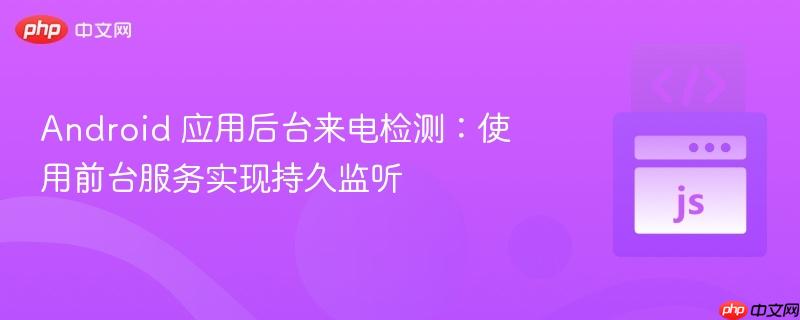
本教程详细介绍了如何在 android 应用中实现后台来电检测功能,即使应用完全关闭也能持续监听。核心方案是利用 android 前台服务(foreground service)配合设备启动广播接收器(boot broadcast receiver),确保服务在系统启动时自动运行,并通过 `phonestatelistener` 实时获取电话状态,从而实现类似 truecaller 的稳定后台来电识别。
在现代 Android 系统中,为了优化电池续航和系统性能,对后台任务的执行施加了严格的限制。这使得应用程序在完全关闭后,很难像 Truecaller 或来电显示应用那样,持续在后台检测来电。传统的 BroadcastReceiver 监听电话状态在应用进程被系统杀死后便无法工作。
解决这一挑战的关键在于使用 Android 的前台服务(Foreground Service)。前台服务是一种特殊的后台服务,它会向用户显示一个持续的通知,表明其正在运行。由于用户可以感知到它的存在,系统会给予前台服务更高的优先级,使其不易被系统终止,从而实现持久的后台任务执行。
前台服务是 Android 中用于执行用户可感知的、需要长时间运行任务的组件。当服务被提升为前台服务时,系统会要求其显示一个通知,该通知不能被用户清除,除非服务被停止或降级为普通后台服务。这确保了用户始终知道有应用正在后台执行重要任务。
对于来电检测场景,前台服务提供了以下优势:
要实现后台来电检测,我们需要完成以下几个关键步骤:声明必要的权限、创建开机启动广播接收器、实现来电检测前台服务,并正确配置 AndroidManifest.xml。
在 AndroidManifest.xml 文件中,我们需要声明以下权限:
<uses-permission android:name="android.permission.READ_PHONE_STATE" /> <uses-permission android:name="android.permission.FOREGROUND_SERVICE" /> <uses-permission android:name="android.permission.RECEIVE_BOOT_COMPLETED" />
这个接收器的作用是在设备启动完成后,自动启动我们的来电检测前台服务。
// BootReceiver.java
package com.example.calldetection;
import android.content.BroadcastReceiver;
import android.content.Context;
import android.content.Intent;
import android.os.Build;
import android.util.Log;
public class BootReceiver extends BroadcastReceiver {
private static final String TAG = "BootReceiver";
@Override
public void onReceive(Context context, Intent intent) {
if (Intent.ACTION_BOOT_COMPLETED.equals(intent.getAction())) {
Log.d(TAG, "Boot completed, starting CallDetectionService.");
Intent serviceIntent = new Intent(context, CallDetectionService.class);
if (Build.VERSION.SDK_INT >= Build.VERSION_CODES.O) {
context.startForegroundService(serviceIntent);
} else {
context.startService(serviceIntent);
}
}
}
}这是核心的服务逻辑,它将注册 PhoneStateListener 来监听电话状态,并在检测到来电时执行相应操作。
// CallDetectionService.java
package com.example.calldetection;
import android.app.Notification;
import android.app.NotificationChannel;
import android.app.NotificationManager;
import android.app.PendingIntent;
import android.app.Service;
import android.content.Context;
import android.content.Intent;
import android.graphics.Color;
import android.os.Build;
import android.os.IBinder;
import android.telephony.PhoneStateListener;
import android.telephony.TelephonyManager;
import android.util.Log;
import androidx.annotation.Nullable;
import androidx.core.app.NotificationCompat;
public class CallDetectionService extends Service {
private static final String TAG = "CallDetectionService";
private static final String CHANNEL_ID = "CallDetectionServiceChannel";
private static final int NOTIFICATION_ID = 101;
private TelephonyManager telephonyManager;
private PhoneStateListener phoneStateListener;
@Override
public void onCreate() {
super.onCreate();
Log.d(TAG, "Service created.");
createNotificationChannel(); // 创建通知渠道
startForeground(NOTIFICATION_ID, buildNotification("来电检测服务正在运行")); // 启动前台服务
telephonyManager = (TelephonyManager) getSystemService(Context.TELEPHONY_SERVICE);
if (telephonyManager != null) {
phoneStateListener = new PhoneStateListener() {
@Override
public void onCallStateChanged(int state, String incomingNumber) {
super.onCallStateChanged(state, incomingNumber);
switch (state) {
case TelephonyManager.CALL_STATE_RINGING:
Log.d(TAG, "Incoming call: " + incomingNumber);
// TODO: 在这里处理来电逻辑,例如显示自定义浮窗、播放提示音等
// 可以发送广播或使用EventBus通知UI层
break;
case TelephonyManager.CALL_STATE_OFFHOOK:
Log.d(TAG, "Call answered or dialing.");
break;
case TelephonyManager.CALL_STATE_IDLE:
Log.d(TAG, "Call ended or no call.");
break;
}
}
};
telephonyManager.listen(phoneStateListener, PhoneStateListener.LISTEN_CALL_STATE);
Log.d(TAG, "PhoneStateListener registered.");
}
}
@Override
public int onStartCommand(Intent intent, int flags, int startId) {
Log.d(TAG, "Service started.");
// 如果服务被系统杀死,系统会尝试重新创建它
return START_STICKY;
}
@Override
public void onDestroy() {
super.onDestroy();
if (telephonyManager != null && phoneStateListener != null) {
telephonyManager.listen(phoneStateListener, PhoneStateListener.LISTEN_NONE);
Log.d(TAG, "PhoneStateListener unregistered.");
}
Log.d(TAG, "Service destroyed.");
}
@Nullable
@Override
public IBinder onBind(Intent intent) {
return null; // 此服务不需要绑定
}
private void createNotificationChannel() {
if (Build.VERSION.SDK_INT >= Build.VERSION_CODES.O) {
NotificationChannel serviceChannel = new NotificationChannel(
CHANNEL_ID,
"来电检测服务",
NotificationManager.IMPORTANCE_LOW // 低优先级通知,不打扰用户但仍可见
);
serviceChannel.setDescription("用于在后台持续检测来电");
serviceChannel.enableLights(false);
serviceChannel.enableVibration(false);
NotificationManager manager = getSystemService(NotificationManager.class);
if (manager != null) {
manager.createNotificationChannel(serviceChannel);
}
}
}
private Notification buildNotification(String content) {
Intent notificationIntent = new Intent(this, MainActivity.class); // 点击通知跳转到主界面
PendingIntent pendingIntent = PendingIntent.getActivity(this,
0, notificationIntent, PendingIntent.FLAG_IMMUTABLE);
return new NotificationCompat.Builder(this, CHANNEL_ID)
.setContentTitle("来电检测")
.setContentText(content)
.setSmallIcon(R.drawable.ic_launcher_foreground) // 替换为你的应用图标
.setContentIntent(pendingIntent)
.setPriority(NotificationCompat.PRIORITY_LOW)
.build();
}
}将 BootReceiver 和 CallDetectionService 声明在 AndroidManifest.xml 中。
<!-- AndroidManifest.xml -->
<manifest xmlns:android="http://schemas.android.com/apk/res/android"
package="com.example.calldetection">
<!-- 声明权限 -->
<uses-permission android:name="android.permission.READ_PHONE_STATE" />
<uses-permission android:name="android.permission.FOREGROUND_SERVICE" />
<uses-permission android:name="android.permission.RECEIVE_BOOT_COMPLETED" />
<application
android:allowBackup="true"
android:icon="@mipmap/ic_launcher"
android:label="@string/app_name"
android:roundIcon="@mipmap/ic_launcher_round"
android:supportsRtl="true"
android:theme="@style/Theme.CallDetection">
<activity android:name=".MainActivity">
<intent-filter>
<action android:name="android.intent.action.MAIN" />
<category android:name="android.intent.category.LAUNCHER" />
</intent-filter>
</activity>
<!-- 声明前台服务 -->
<service
android:name=".CallDetectionService"
android:enabled="true"
android:exported="false" />
<!-- 声明开机启动广播接收器 -->
<receiver
android:name=".BootReceiver"
android:enabled="true"
android:exported="true">
<intent-filter>
<action android:name="android.intent.action.BOOT_COMPLETED" />
<category android:name="android.intent.category.DEFAULT" />
</intent-filter>
</receiver>
</application>
</manifest>以上代码片段已经包含了实现后台来电检测所需的主要部分。请确保将 MainActivity.class 替换为你的主 Activity,并根据你的项目结构调整包名和资源。
关键点:
运行时权限请求: READ_PHONE_STATE 是危险权限,在 Android 6.0 (API 级别 23) 及更高版本上,你需要动态请求此权限。在你的 MainActivity 或其他启动 Activity 中添加权限请求逻辑。
// 示例:在Activity中请求权限
if (ContextCompat.checkSelfPermission(this, Manifest.permission.READ_PHONE_STATE)
!= PackageManager.PERMISSION_GRANTED) {
ActivityCompat.requestPermissions(this,
new String[]{Manifest.permission.READ_PHONE_STATE},
PERMISSION_REQUEST_CODE);
}用户体验与通知:
电池消耗: 尽管前台服务优先级高,但持续运行仍会消耗电池。PhoneStateListener 本身消耗不大,但如果你的来电处理逻辑涉及复杂的网络请求或计算,应注意优化。
Android 版本兼容性:
服务生命周期管理: 确保在不再需要服务时(例如用户在应用设置中禁用此功能),能够正确停止服务。可以通过 stopService(new Intent(context, CallDetectionService.class)) 来停止。
进程管理: 即使是前台服务,在极端内存压力下也可能被系统杀死。START_STICKY 返回值告诉系统,如果服务被杀死,尝试在可用时重新创建它。
通过巧妙地结合 Android 前台服务和开机启动广播接收器,我们可以有效地实现在应用完全关闭后仍能持续检测来电的功能。这种方法确保了服务的稳定性和持久性,同时通过强制性的通知机制,维护了用户对后台活动的知情权。在实现过程中,务必关注权限管理、用户体验和不同 Android 版本的兼容性,以构建一个健壮且符合系统规范的来电检测应用。
以上就是Android 应用后台来电检测:使用前台服务实现持久监听的详细内容,更多请关注php中文网其它相关文章!

每个人都需要一台速度更快、更稳定的 PC。随着时间的推移,垃圾文件、旧注册表数据和不必要的后台进程会占用资源并降低性能。幸运的是,许多工具可以让 Windows 保持平稳运行。

Copyright 2014-2025 https://www.php.cn/ All Rights Reserved | php.cn | 湘ICP备2023035733号